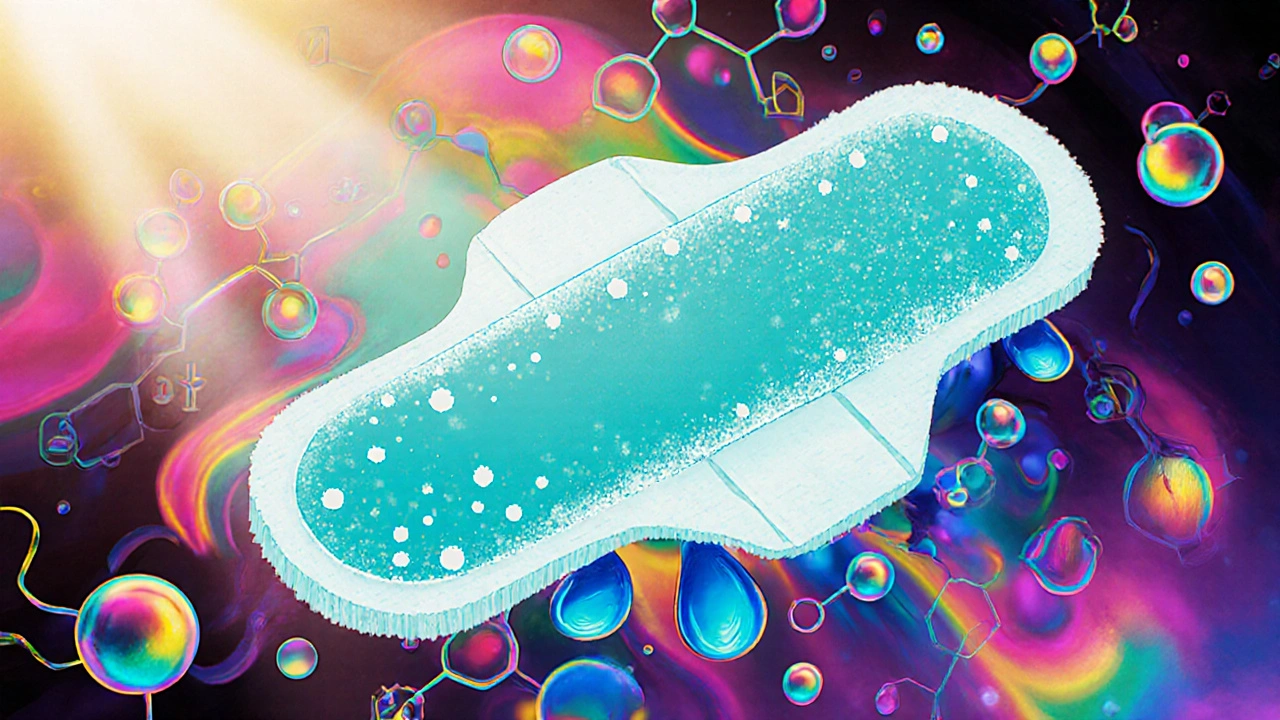Feminine Hygiene Product Ingredient Checker
Find Your Best Product Match
Your Recommendation
Select your preferences above to see personalized recommendations.
Ever wondered why some pads promise “antibacterial protection” or “soothing zinc”? The answer lies in two chemistry staples: benzalkonium chloride is a quaternary ammonium compound used as a broad‑spectrum disinfectant and zinc oxide, a mineral pigment that also has mild antimicrobial and skin‑protective properties. Both end up in many feminine hygiene products, but they serve different jobs and have distinct safety profiles. Let’s break down what they are, why they’re added, and how to decide if a product is right for you.
What exactly are benzalkonium chloride and zinc oxide?
Benzalkonium chloride (often abbreviated BAC) belongs to the quaternary ammonium class. It works by disrupting the cell membranes of bacteria, fungi, and some viruses, leading to rapid kill rates. In the US, the Food and Drug Administration (FDA) classifies it as a "generally recognized as safe" (GRAS) preservative when used at low concentrations (usually under 0.1% in topical products).
Zinc oxide is an inorganic compound best known for its white, opaque appearance. Beyond its role in sunscreens, zinc oxide releases zinc ions that can inhibit bacterial growth and calm irritated skin. The European Medicines Agency (EMA) permits zinc oxide up to 20% in over‑the‑counter skin products, citing a low risk of systemic absorption.
Why do these ingredients matter in feminine hygiene?
Women’s intimate area is warm, moist, and exposed to frequent changes in pH. That environment can encourage bacterial overgrowth, leading to odor, itching, or even infections. Adding an antibacterial or soothing agent can help:
- Reduce the growth of odor‑causing bacteria like Staphylococcus and Corynebacterium.
- Minimize the risk of skin irritation from friction or moisture.
- Provide a “fresh” feeling that many users associate with confidence during their period.
Both benzalkonium chloride and zinc oxide aim to achieve these goals, but they approach them differently.
How are they incorporated into pads, tampons, and liners?
Manufacturers embed these compounds at distinct stages of production. Below is a quick look at the typical workflow:
- Core material preparation: The absorbent core (usually a blend of wood pulp and super‑absorbent polymer) is mixed with a liquid solution containing the active ingredient. \n
- Top‑sheet coating: For pads and liners, a thin film of the agent may be sprayed onto the top sheet that contacts the skin. This ensures the active is delivered where it’s needed most.
- Bonding and drying: The coated layer is dried under controlled temperature to lock the compound into place without compromising the pad’s softness.
- Final assembly: The finished core is sandwiched between the top sheet and back sheet, then cut to size.
In tampons, the process is a bit tighter because the material is compacted. A low‑dose spray of benzalkonium chloride may be applied after the cotton is formed, while zinc oxide particles are sometimes blended directly into the cotton fibers during the spinning stage.

Safety limits and regulations
Regulatory bodies keep a close eye on antimicrobial additives. Here’s what you need to know:
- Concentration caps: In the US, benzalkonium chloride is typically limited to 0.1% w/w in disposable hygiene products. Zinc oxide can appear up to 5% w/w in pads and up to 20% in creams, but most manufacturers stay under 2% for comfort.
- Allergy warnings: Although rare, some people experience contact dermatitis from benzalkonium chloride, especially if they have a history of skin sensitivities. Zinc oxide is generally hypoallergenic, but it can cause a temporary white residue on the skin.
- Environmental concerns: Quaternary ammonium compounds can linger in wastewater. Manufacturers are now exploring biodegradable alternatives or lower‑dose formulations.
Both FDA and EMA require that any claim like “antibacterial” be backed by clinical data. Look for a product label that cites a study or a certification number.
Benefits vs. drawbacks - a side‑by‑side look
| Aspect | Benzalkonium chloride | Zinc oxide |
|---|---|---|
| Primary function | Broad‑spectrum antimicrobial | Skin soothing, mild antimicrobial |
| Typical concentration | 0.05%‑0.1% w/w | 0.5%‑2% w/w (up to 20% in creams) |
| Effect on odor | Strong reduction of odor‑causing bacteria | Modest odor control via skin health |
| Risk of irritation | Possible contact dermatitis in sensitive users | Very low; may leave a white residue |
| Regulatory status (US) | GRAS, limited to 0.1% in top‑sheet coatings | Allowed in OTC skin products up to 20% |
| Environmental impact | Persistent in water, potential ecotoxicity | Inert mineral, low ecological risk |
In short, benzalkonium chloride packs a stronger antibacterial punch, while zinc oxide leans toward comfort and skin protection. Your choice depends on whether you prioritize odor control or gentle soothing.

Tips for picking the right product
- Check the label: Look for “contains benzalkonium chloride” or “zinc oxide” with the exact percentage listed.
- Know your skin: If you have a history of contact allergy, steer clear of benzalkonium chloride and opt for zinc‑oxide‑based pads.
- Consider the cycle length: For heavy flow days, a higher‑dose antibacterial pad may keep you feeling fresher. On lighter days, a zinc‑oxide‑infused liner can be enough.
- Mind the environment: Brands that advertise “biodegradable” or “low‑dose antimicrobial” are usually trying to reduce the ecological footprint of quaternary compounds.
- Test before you trust: Use a single pad overnight. If you notice redness, itching, or a white residue, switch to a product without the offending ingredient.
Future trends - what’s next for antimicrobial hygiene?
Researchers are experimenting with natural alternatives like chitosan (derived from shrimp shells) and silver‑nanoparticle‑embedded fibers. These aim to keep the antibacterial edge while cutting down on synthetic chemicals. Keep an eye on product announcements that mention “bio‑based antimicrobial” - they may become the next standard.
Frequently Asked Questions
Is benzalkonium chloride safe for everyday use?
Yes, when used at the low concentrations required by FDA (≤0.1% w/w) it is considered safe for most people. Those with known skin sensitivities should avoid it.
Can zinc oxide cause any side effects?
Zinc oxide is generally non‑irritating. The most common side effect is a faint white film on the skin, which washes off easily.
Do antimicrobial pads reduce the risk of infections?
They can lower bacterial load and odor, but they do not replace good hygiene practices. For recurrent infections, consult a healthcare provider.
Are these ingredients listed on the packaging?
Regulations require manufacturers to disclose active antimicrobial agents. Look for a “ingredients” or “active components” section on the side panel.
What should I do if I develop a rash after using a product?
Stop using the product immediately, rinse the area with cool water, and apply a hypoallergenic moisturizer. If the rash persists, see a doctor.
Understanding how benzalkonium chloride and zinc oxide work helps you make smarter choices during your period. Whether you prioritize a strong antibacterial shield or a gentle soothing layer, the right product is out there - just read the label and listen to your body.





parth gajjar
October 19, 2025 AT 17:24Behold the hidden chemistry in our pads a silent guardian and a silent tyrant alike
Maridel Frey
October 28, 2025 AT 11:40Understanding the mechanisms behind benzalkonium chloride and zinc oxide empowers consumers to make informed decisions. By examining the concentration limits and potential skin reactions, individuals can tailor their hygiene choices to personal sensitivities. It is essential to review product labels carefully and seek reputable sources when evaluating antimicrobial claims.
DHARMENDER BHATHAVAR
November 6, 2025 AT 06:46The active agents are listed on the packaging. Verify the percentage of benzalkonium chloride or zinc oxide. Choose based on your skin tolerance.
Jay Kay
November 15, 2025 AT 01:53Honestly most people don’t realize that the “antibacterial” claim is just marketing hype. A sprinkle of BAC can kill germs but also strip the natural flora. If you want real comfort you’re better off with a simple zinc‑oxide liner.
Rakhi Kasana
November 23, 2025 AT 21:00While the marketing angle can be overblown, the antimicrobial effect isn’t entirely fictitious. For those prone to infection a low dose of BAC does offer measurable odor reduction. Nevertheless, personal comfort should remain the priority.
James Dean
December 2, 2025 AT 16:06Life’s smallest protections often go unnoticed like these compounds silently shaping daily comfort
Monika Bozkurt
December 11, 2025 AT 11:13When evaluating the inclusion of benzalkonium chloride and zinc oxide within feminine hygiene articles, a comprehensive risk‑benefit analysis is warranted. First, the pharmacokinetic profile of these agents demonstrates minimal dermal absorption at concentrations sanctioned by regulatory agencies, thereby limiting systemic exposure. Second, the antimicrobial spectrum of benzalkonium chloride, encompassing Gram‑positive and Gram‑negative organisms, underpins its efficacy in reducing odorogenic bacterial load. Third, zinc oxide contributes to epidermal barrier reinforcement through its anti‑inflammatory properties and mild astringent action. Fourth, the synergistic interaction between the two compounds can be calibrated to achieve both antiseptic potency and soothing comfort without compromising biocompatibility. Fifth, adverse event surveillance data indicate that contact dermatitis attributable to benzalkonium chloride remains a low‑incidence phenomenon, predominantly observed in individuals with pre‑existing dermatologic hypersensitivity. Sixth, zinc oxide’s inert mineral nature renders it largely hypoallergenic, although a transient white film may be perceived by some users. Seventh, the manufacturing processes that embed these actives-core impregnation and top‑sheet coating-ensure homogenous distribution, mitigating localized concentration spikes that could provoke irritation. Eighth, environmental considerations warrant attention; quaternary ammonium residues exhibit persistence in wastewater, prompting ongoing research into biodegradable alternatives. Ninth, from a regulatory perspective, the FDA’s GRAS designation for benzalkonium chloride and EMA’s permissive stance on zinc oxide provide a robust legal framework for product developers. Tenth, consumer education remains pivotal; transparent labeling that discloses exact percentages empowers end‑users to align product selection with individual risk tolerance. Eleventh, clinical trial data supporting antibacterial claims must meet stringent methodological criteria to substantiate marketing assertions. Twelfth, the integration of these ingredients should be contextualized within a broader hygiene regimen that includes regular genital cleansing and appropriate garment selection. Thirteenth, product innovators are exploring adjunctive natural antimicrobials such as chitosan and silver nanoparticles to further enhance efficacy while reducing synthetic chemical load. Fourteenth, ongoing post‑market surveillance will elucidate long‑term safety trends as usage patterns evolve. Fifteenth, ultimately the decision to adopt a benzalkonium chloride‑ or zinc‑oxide‑infused product hinges upon a personalized appraisal of antimicrobial benefit versus potential cutaneous sensitivity.